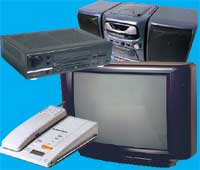|
When we say "vampire power," we don't mean the hypnotic power of some black-caped, white-fanged Transylvanian. We mean the electricity your
 home electronics and appliances suck out of the power grid when you're not using them. (Of course, we realize that the TV has a certain hypnotic, vampirish power over us, but that's a different problem.)
home electronics and appliances suck out of the power grid when you're not using them. (Of course, we realize that the TV has a certain hypnotic, vampirish power over us, but that's a different problem.)
If you're a conscientious user of appliances and gadgets, you always turn them off when you're not using them. But many electronics don't actually go all the way off—they continue using "standby power." Some examples of features that require standby power are:
- internal clocks and sensors;
- external clock displays and panel display LEDs;
- remote control sensors;
- battery rechargers and power-conversion packs;
- communications between a base unit and a portable unit (as in a portable phone).
This article provides some statistics on how much vampire power is costing you and offers tips for reducing your vampire-power problem in the future.
The amount of standby power wasted varies among electronic equipment, but overall, the cost to consumers and businesses for all the electricity lost to vampire power in the US is estimated to be $4 billion annually. The International Energy Agency (IEA) estimates the global energy consumption due to standby power at between 200-400 terawatts per year.
|
Not all of this vampire power is truly wasted—after all, many of the features in modern electronics that require standby power are either critical for proper functioning of the unit or are associated with desirable features. Most wasted standby power is consumed by inefficient power supplies and components that are getting power unnecessarily. An Australian study of global standby power usage in electronic devices estimated that electronics manufacturers could reduce vampire power by 30% right off the bat just by using existing, better technologies—and with minimal additional cost to consumers.
|
|
WHERE DO THE VAMPIRES DWELL? |
|
Exact figures on total losses to standby power are not available, but the most recent major survey on the subject estimated that in the United States, 5% of electricity usage is due to standby power. In Europe, the numbers run slightly higher: France at 7% and Germany and the Netherlands at 10% each. Australia comes in at 11%, Japan at 12%.
|
|
Depending on the efficiency of your unit's design, the standby power use can be minimal or substantial. And even though home electronics aren't typically the biggest electricity users in a house, vampire power can still cost you up to 10% of your electric bill.
To some extent, vampire power is only one factor in overall power use for electronic devices. Different units can vary in their "in-use efficiency" too. So really, what we want to look at is the overall energy efficiency of the unit, whether it's off or on, and get an estimate of the total power likely to be consumed by a typical consumer over an average year.
The US EnergyStar program has done a lot to empower consumers by providing energy efficiency ratings for various categories of electronics. To get the EnergyStar label, products must meet stringent energy-efficiency criteria. So, when you shop here in the US, make sure the product is EnergyStar-rated. For some categories, such as refrigerators and freezers, there will also be a numerical efficiency rating that can help you further narrow your choice.
|
The EnergyStar web site has a slew of pages designed to help you find models that qualify for the EnergyStar label. Each product page gives an overview of the energy considerations for the particular electronics category, provides a mini-search engine to help you find brands that qualify, and give information about other important product characteristics that will help you make smart purchases. Product pages are available for many categories; we list the most popular ones below.
|
HUNT DOWN THOSE
BLOODY POWER DRAINERS! |
|
There's a cool little gadget available that can help you determine which of your plug-in items are the most inefficient power consumers.
 It's the Kill-A-Watt electricity usage monitor. You just plug it into the wall outlet and then plug your electrical device into the Kill-a-Watt monitor. It will allow you to assess how efficient the electrical device is. You can calculate the item's electrical cost by the day, week, month, or year to help you decide whether a more efficient model would save you money over time. Check out the Kill-A-Watt monitor at Amazon.com
It's the Kill-A-Watt electricity usage monitor. You just plug it into the wall outlet and then plug your electrical device into the Kill-a-Watt monitor. It will allow you to assess how efficient the electrical device is. You can calculate the item's electrical cost by the day, week, month, or year to help you decide whether a more efficient model would save you money over time. Check out the Kill-A-Watt monitor at Amazon.com
|
|
- Consumer electronics, like TVs, VCRs, and DVD players, as well as cordless phones and phone/answering machines;
- Computer and office equipment, including CPUs, monitors, printers, scanners, fax machines, copiers, and water coolers;
- Major appliances like refrigerators, freezers, dishwashers, and clothes washers;
- Heating, ventilating, and air conditioning (HVAC) equipment, as well as fans, dehumidifiers, and air purifiers;
- Light fixtures and compact fluorescent light bulbs (CFLs).
Go to the EnergyStar web site
 When you replace a piece of electronic gear that's got a big vampire-power factor with one that's more efficiently designed, you save money over the long run. But remember, since power plants produce pollution when they generate electricity for you, reducing wasted vampire power also helps reduce pollution. We'll all breathe easier when the power vampires are dead!
When you replace a piece of electronic gear that's got a big vampire-power factor with one that's more efficiently designed, you save money over the long run. But remember, since power plants produce pollution when they generate electricity for you, reducing wasted vampire power also helps reduce pollution. We'll all breathe easier when the power vampires are dead!
Know an energy ghoul who might like this Vampire Power article? Please forward it to them.
|
Books:
- See books related to vampire power and saving electricity
More articles and resources for....
Search Amazon.com for....
|
| |
RELATED GP ARTICLES
|
| |
|
BE A SUNSHINE SUPERMAN (OR WOMAN) — POWER YOUR HOME WITH SOLAR!
Home Solar Energy
— Systems and Strategies
YOU'LL HAVE TO TAKE A QUIZ IF YOU WANT TO SIT AT THE ENERGY BAR
Munch on a Handful of
Energy Quizzes, Smarty Pants!
THE THREE LAWS OF OUR ENERGY PEAK FUTURE: LOCAL, LOCAL, LOCAL
The Coming Energy Peak and the Need for
Global Re-Localization
|
| |
|
Get Grinning Planet free via email
|


